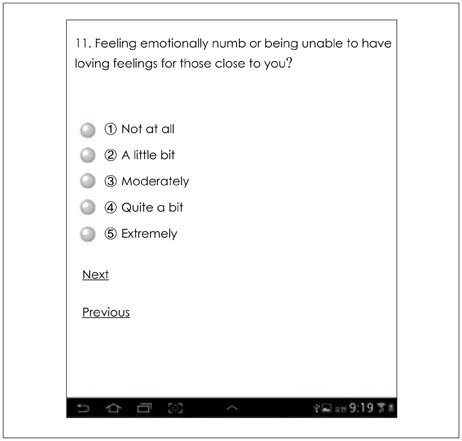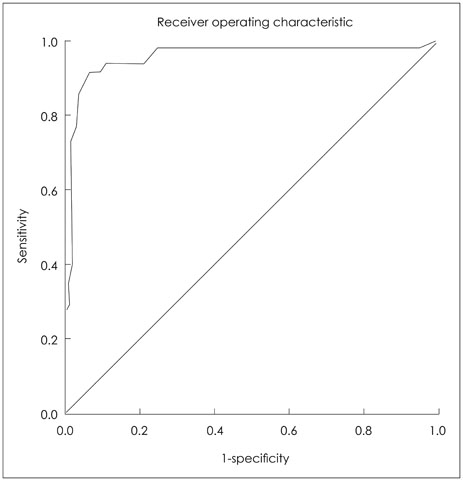J Korean Neuropsychiatr Assoc.
2015 May;54(2):236-244. 10.4306/jknpa.2015.54.2.236.
Application of Mobile App and Paper Survey of PTSD Checklist in the Elderly Korean Veterans of the Vietnam War
- Affiliations
-
- 1Department of Neuropsychiatry, Veterans Health Service Medical Center, Seoul, Korea. alkadien@naver.com
- KMID: 2343904
- DOI: http://doi.org/10.4306/jknpa.2015.54.2.236
Abstract
OBJECTIVES
The posttraumatic stress disorder (PTSD) checklist (PCL) is currently the most popular self-report scale employed in screening PTSD. This study was conducted 1) to test the reliability and validity of PCL in veterans of the Vietnam War and 2) to compare the results when using a conventional paper survey and mobile app survey.
METHODS
Participants included 186 Korean veterans of the Vietnam War. Mini Mental Status Examination, PTSD module of Structured Clinical Interview for DSM-IV (SCID), and Life Event Checklist were administered. PCL was administered in either written format or mobile app. Diagnostic validity of the PCL was compared using the PTSD module of SCID. Other psychometric properties of PCL were also calculated.
RESULTS
PCL results using different methods, paper and mobile app, showed no significant difference in each item and total score. Cronbach's coefficient of PCL was 0.95, optimal cut-off 49.5, sensitivity 91.7%, and specificity 93.5%.
CONCLUSION
PCL showed excellent internal reliability, sensitivity, specificity, and validity. There was no statistically significant difference between survey methods. These results suggest that PCL is a reliable self-report scale in veterans. In addition, PCL with mobile app can be helpful in screening PTSD.
Keyword
MeSH Terms
Figure
Reference
-
1. Kisa.or.kr [homepage on the Internet]. A study on gender and age in the society of smartphone users. KISA;cited 2014 Oct 14. Available from: http://www.kisa.or.kr/public/library/IS_List.jsp.2. Lee DA, Scragg P, Turner S. The role of shame and guilt in traumatic events: a clinical model of shame-based and guilt-based PTSD. Br J Med Psychol. 2001; 74(Pt 4):451–466.
Article3. Wells M, Mitchell KJ, Finkelhor D, Becker-Blease KA. Online mental health treatment: concerns and considerations. Cyberpsychol Behav. 2007; 10:453–459.
Article4. American Psychiatric Association. Diagnostic and statistical manual of mental disorders: DSM-IV-TR. 4th ed. Washington, DC: American Psychiatric Association;2000.5. Kessler RC, Sonnega A, Bromet E, Hughes M, Nelson CB. Posttraumatic stress disorder in the National Comorbidity Survey. Arch Gen Psychiatry. 1995; 52:1048–1060.
Article6. Resnick HS, Kilpatrick DG, Dansky BS, Saunders BE, Best CL. Prevalence of civilian trauma and posttraumatic stress disorder in a representative national sample of women. J Consult Clin Psychol. 1993; 61:984–991.
Article7. McFarlane AC. Long-term psychiatric morbidity after a natural disaster. Implications for disaster planners and emergency services. Med J Aust. 1986; 145:561–563.
Article8. Sierles FS, Chen JJ, McFarland RE, Taylor MA. Posttraumatic stress disorder and concurrent psychiatric illness: a preliminary report. Am J Psychiatry. 1983; 140:1177–1179.
Article9. Keane TM, Kaloupek DG. Comorbid psychiatric disorders in PTSD. Implications for research. Ann N Y Acad Sci. 1997; 821:24–34.10. Vetter S, Rossegger A, Elbert T, Gerth J, Urbaniok F, Laubacher A, et al. Internet-based self-assessment after the Tsunami: lessons learned. BMC Public Health. 2011; 11:18.
Article11. Knaevelsrud C, Maercker A. Does the quality of the working alliance predict treatment outcome in online psychotherapy for traumatized patients? J Med Internet Res. 2006; 8:e31.
Article12. Kuhn E, Greene C, Hoffman J, Nguyen T, Wald L, Schmidt J, et al. Preliminary evaluation of PTSD Coach, a smartphone app for post-traumatic stress symptoms. Mil Med. 2014; 179:12–18.
Article13. Weathers FW, Litz BT, Herman DS, Huska JA, Keane TM. The PTSD Checklist (PCL): Reliability, validity, and diagnostic utility. In : Proceedings of the Annual Conference of the International Society for Traumatic Stress Studies; 1993 Oct 25; San Antonio, TX.14. Spoont M, Arbisi P, Fu S, Greer N, Kehle-Forbes S, Meis L, et al. Screening for Post-Traumatic Stress Disorder (PTSD) in Primary Care: A Systematic Review. Washington, DC: Department of Veterans Affairs;2013.15. Keen SM, Kutter CJ, Niles BL, Krinsley KE. Psychometric properties of PTSD Checklist in sample of male veterans. J Rehabil Res Dev. 2008; 45:465–474.
Article16. Palmieri PA, Weathers FW, Difede J, King DW. Confirmatory factor analysis of the PTSD Checklist and the Clinician-Administered PTSD Scale in disaster workers exposed to the World Trade Center Ground Zero. J Abnorm Psychol. 2007; 116:329–341.
Article17. Cordova MJ, Andrykowski MA, Kenady DE, McGrath PC, Sloan DA, Redd WH. Frequency and correlates of posttraumatic-stress-disorder-like symptoms after treatment for breast cancer. J Consult Clin Psychol. 1995; 63:981–986.
Article18. Lang AJ, Wilkins K, Roy-Byrne PP, Golinelli D, Chavira D, Sherbourne C, et al. Abbreviated PTSD Checklist (PCL) as a guide to clinical response. Gen Hosp Psychiatry. 2012; 34:332–338.
Article19. Adkins JW, Weathers FW, McDevitt-Murphy M, Daniels JB. Psychometric properties of seven self-report measures of posttraumatic stress disorder in college students with mixed civilian trauma exposure. J Anxiety Disord. 2008; 22:1393–1402.
Article20. Cook JM, Elhai JD, Areán PA. Psychometric properties of the PTSD Checklist with older primary care patients. J Trauma Stress. 2005; 18:371–376.
Article21. Crabb RM, Rafie S, Weingardt KR. Health-related internet use in older primary care patients. Gerontology. 2012; 58:164–170.
Article22. Trustram Eve C, de Jager CA. Piloting and validation of a novel self-administered online cognitive screening tool in normal older persons: the Cognitive Function Test. Int J Geriatr Psychiatry. 2014; 29:198–206.
Article23. Zou JB, Dear BF, Titov N, Lorian CN, Johnston L, Spence J, et al. Brief internet-delivered cognitive behavioral therapy for anxiety in older adults: a feasibility trial. J Anxiety Disord. 2012; 26:650–655.
Article24. Mewton L, Sachdev PS, Andrews G. A naturalistic study of the acceptability and effectiveness of internet-delivered cognitive behavioural therapy for psychiatric disorders in older australians. PLoS One. 2013; 8:e71825.
Article25. Foa EB, Tolin DF. Comparison of the PTSD Symptom Scale-Interview Version and the Clinician-Administered PTSD scale. J Trauma Stress. 2000; 13:181–191.
Article26. Blake DD, Weathers FW, Nagy LM, Kaloupek DG, Gusman FD, Charney DS, et al. The development of a Clinician-Administered PTSD Scale. J Trauma Stress. 1995; 8:75–90.
Article27. Dobie DJ, Kivlahan DR, Maynard C, Bush KR, McFall M, Epler AJ, et al. Screening for post-traumatic stress disorder in female Veteran's Affairs patients: validation of the PTSD checklist. Gen Hosp Psychiatry. 2002; 24:367–374.
Article28. Walker EA, Newman E, Dobie DJ, Ciechanowski P, Katon W. Validation of the PTSD checklist in an HMO sample of women. Gen Hosp Psychiatry. 2002; 24:375–380.
Article29. Yeager DE, Magruder KM, Knapp RG, Nicholas JS, Frueh BC. Performance characteristics of the posttraumatic stress disorder checklist and SPAN in Veterans Affairs primary care settings. Gen Hosp Psychiatry. 2007; 29:294–301.
Article30. Yeager DE, Magruder KM. PTSD checklist scoring rules for elderly Veterans Affairs outpatients. Am J Geriatr Psychiatry. 2014; 22:545–550.
Article
- Full Text Links
- Actions
-
Cited
- CITED
-
- Close
- Share
- Similar articles
-
- The Relationship between Posttraumatic Stress Disorder and the Quality of Life among the Vietnam War Veterans
- Observations from the Korean War for Modern Military Medicine
- Embitterment in Vietnam War Veterans Predicted by Symptoms of Posttraumatic Stress Disorder
- The Cognitive Profiles of Partial PTSD in Vietnam War Veterans
- Effects of Sertraline on Memory Function of Patients with Posttraumatic Stress Disorder




